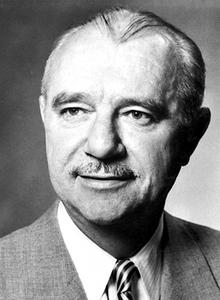Vincent du Vigneaud
Vincent du Vigneaud | |
|---|---|
 | |
| Born | May 18, 1901 Chicago, Illinois, USA |
| Died | December 11, 1978 (aged 77) Ithaca, New York, USA |
| Nationality | United States |
| Alma mater | University of Rochester |
| Awards | Albert Lasker Award for Basic Medical Research (1948) Nobel Prize for Chemistry (1955) Willard Gibbs Award (1956) |
| Scientific career | |
| Fields | Chemistry |
| Doctoral advisor | John R. Murlin |
Vincent du Vigneaud (May 18, 1901 – December 11, 1978) was an American biochemist. He won a Nobel Prize in Chemistry in 1955 for the isolation, structural identification, and total synthesis of the cyclic peptide, oxytocin.[1]
Biography
Du Vigneaud graduated from Schurz High School in 1918. He began studying chemistry at the University of Illinois at Urbana-Champaign. He was influenced by lectures of Carl Shipp Marvel. After receiving his M.S. in 1924 he joined DuPont.
He married Zella Zon Ford on June 12, 1924. Restarting his academic career in 1925, he joined the group of John R. Murlin at the University of Rochester for his Ph.D thesis. He graduated in 1927 with his work, The Sulfur in Insulin.
After post-doctoral position with John Jacob Abel at Johns Hopkins University Medical School (1927-1928), he traveled to Europe as National Research Council Fellow in 1928-1929, where he worked with Max Bergmann at the Kaiser Wilhelm Institute for Leather Research in Dresden, and with George Barger at the University of Edinburgh Medical School. He then returned to the University of Illinois as a professor.[2]
He next went to George Washington University Medical School in Washington, D.C. in 1932 and to Cornell Medical College in New York City in 1938, where he stayed until his emeritation in 1967. Following that retirement, he held a position at Cornell University in Ithaca, New York.
In 1974 he suffered from a stroke which ended his academic career. One year after his wife's death in 1977, he died.
Career
His career was characterized by an interest in sulfur, proteins, and especially, peptides. Even before his famous work on elucidating and synthesizing oxytocin and vasopressin, he had established a reputation for work on insulin, biotin, transmethylation, and penicillin.[3]
He also began a series of structure-activity relationships for oxytocin and vasopressin, perhaps the first for peptides. That work culminated in the publication of a book entitled, A Trail of Research in Sulphur Chemistry and Metabolism and Related Field.[4]
Legacy
He joined Alpha Chi Sigma while at the University of Illinois in 1930.
References
- ^ Du Vigneaud V, Ressler C, Swan JM, RobertsCWand Katsoyannis PG (1954). "Oxytocin: synthesis". Journal of the American Chemical Society. 76 (12): 3115–3118. doi:10.1021/ja01641a004.
{{cite journal}}: CS1 maint: multiple names: authors list (link) - ^ Hofmann, Klaus. "Vincent du Vigneaud" (PDF). National Academy of Sciences. Retrieved 20 September 2012.
- ^ Ragnarsson, Ulf (2007). "The Nobel trail of Vincent du Vigneaud". Journal of Peptide Science. Vol. 13, no. 7 (published Jul 2007). pp. 431–3. doi:10.1002/psc.864. PMID 17554806.
- ^ http://www.nndb.com/people/456/000100156
External links
- 1901 births
- 1978 deaths
- American biochemists
- American biologists
- American Nobel laureates
- Cornell University faculty
- American people of French descent
- Nobel laureates in Chemistry
- Recipients of the Albert Lasker Award for Basic Medical Research
- University of Illinois at Urbana–Champaign alumni
- Academics of the University of Edinburgh
- George Washington University faculty
- Scientists from Chicago, Illinois

